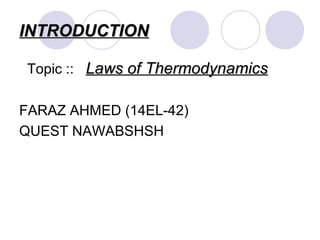
Laws of thermodynamics
- 1. INTRODUCTIONINTRODUCTION Topic :: Laws of ThermodynamicsLaws of Thermodynamics FARAZ AHMED (14EL-42) QUEST NAWABSHSH
- 2. ThermodynamicsThermodynamics Thermodynamics is the branch of physics that is built upon the fundamental laws that heat and work obey. Thermodynamics is the study of the effects of work, heat, and energy on a system. Thermodynamics is only concerned with macroscopic (large-scale) changes and observations. Thermodynamics is the science of the relationship between heat, work and systems that analuze energy processes.
- 3. Law of ThermodynamicsLaw of Thermodynamics •The Zeroth law of Thermodynamics. • The First Law of Thermodynamics. •The Second Law of Thermodynamics •The Third Law of Thermodynamics
- 4. The Zeroth Law of ThermodynamicsThe Zeroth Law of Thermodynamics If object A is in thermal equilibrium with object C, and object B is separately in thermal equilibrium with object C, then objects A and B will be in thermal equilibrium if they are placed in thermal contact.
- 5. The First Law of ThermodynamicsThe First Law of Thermodynamics The first law of thermodynamics, also known as Law of Conservation of Energy, Energy can neither be created nor destroyed; it can only be transferred or changed from one form to another A way of expressing the first law of thermodynamics is that any change in the internal energy(∆E) of a system is given by the sum of the heat (Q) that flows across its boundaries and the work (W) done on the system by the surroundings: ΔE = Q + W
- 6. Application Of First Law of ThermodynamicsApplication Of First Law of Thermodynamics Isobaric – constant pressure Isochoric – constant volume Isothermal – constant temperature Adiabatic – no heat transferred
- 7. IIsobaric processsobaric process An isobaric process is a constant pressure process. ΔU, W, and Q are generally non-zero. work done by an ideal gas is W = P·ΔV Water boiling in a saucepan is an example of an isobaric process
- 8. IIsochoric processsochoric process An isochoric process is a constant volume process. When the volume of a system doesn’t change, it will do no work on its surroundings. W = 0 ΔU = Q Heating gas in a closed container is an example of isochoric process
- 9. Isothermal processIsothermal process An isothermal process is a constant temperature process. Any heat flow into or out of the system must be slow enough to maintain thermal equilibrium For ideal gases, if ΔT is zero, ΔU = 0 Therefore, Q = W Any energy entering the system (Q) must leave as work (W)
- 10. Adiabatic processAdiabatic process An adiabatic process no heat transfer or leave the system i-e Q=0 • Therefore ΔU = – W When a system expands adiabatically, W is positive (the system does work) so ΔU is negative, i-e W = - ΔU When a system compresses adiabatically, W is negative (work is done on the system) so ΔU is positive. - W = ΔU
- 11. The Second Law of ThermodynamicsThe Second Law of Thermodynamics Heat cannot be converted fully to work. Heat is transferred spontaneously only from a high temperature body to a low temperature body. (Spontaneously: without applying external work). The entropy of an isolated system never decreases. It is impossible to construct a heat engine which is 100% efficient. Thus, a heat engine can convert some of input heat into useful work, but the rest must be exhausted as waste heat.
- 12. The Third Law of ThermodynamicsThe Third Law of Thermodynamics "The entropy of a pure perfect crystal is zero (0) at zero Kelvin (0 K). the temperature of a system approaches absolute zero, its entropy approaches a constant (for pure perfect crystals, this constant is zero).
- 13. Pure Perfect Crystal: A pure perfect crystal is one in which every molecule is identical Entropy can become zero. Non Pure Crystal: A pure perfect crystal is one in which every molecule is not identical Entropy cannot become zero.
- 14. EXAMPLEEXAMPLE Water in gas form has molecules that can move around very freely. Water vapor has very high entropy (randomness). As the gas cools, it becomes liquid. The liquid water molecules can still move around, but not as freely. They have lost some entropy. When the water cools further, it becomes solid ice. The solid water molecules can no longer move freely, but can only vibrate within the ice crystals. The entropy is now very low. As the water is cooled more, closer and closer to absolute zero, the vibration of the molecules diminishes. If the solid water reached absolute zero, all molecular motion would stop completely. At this point, the water would have no entropy (randomness) at all.